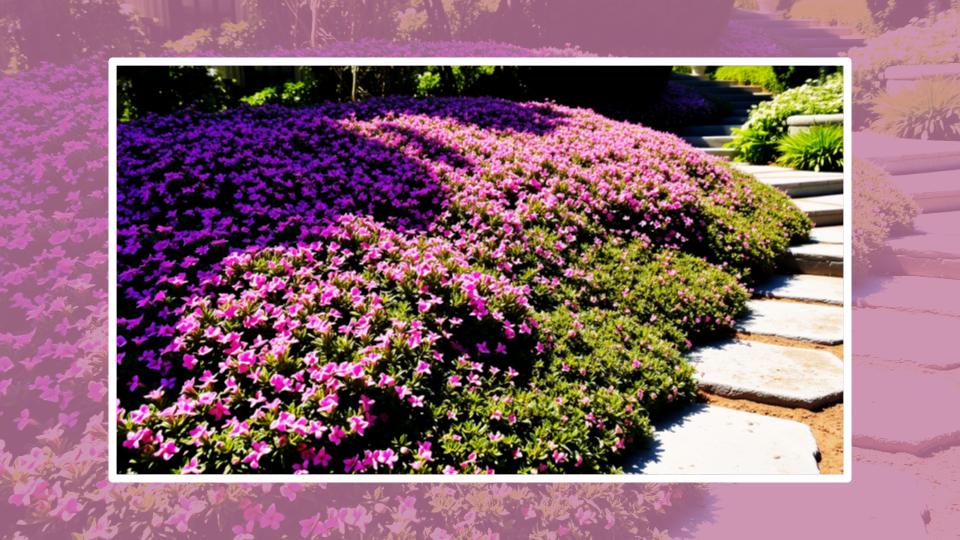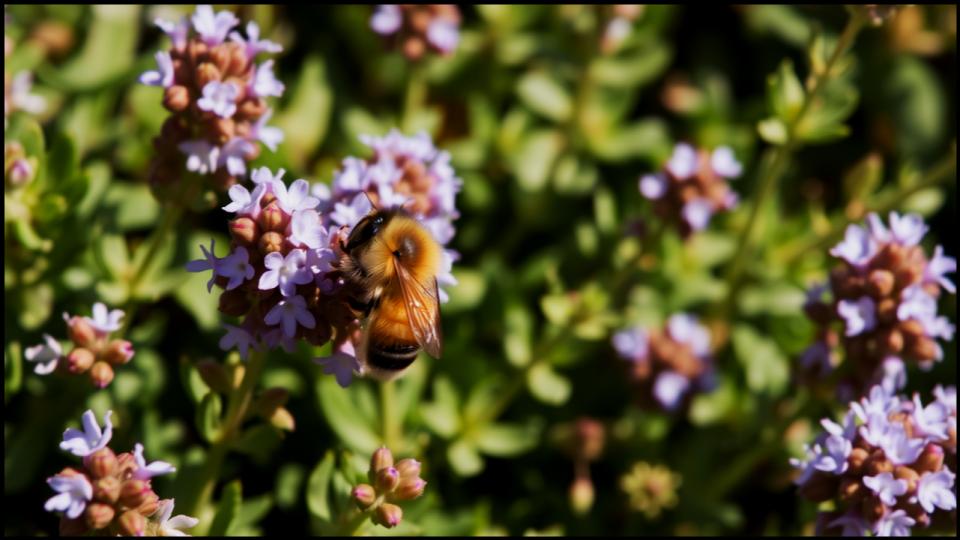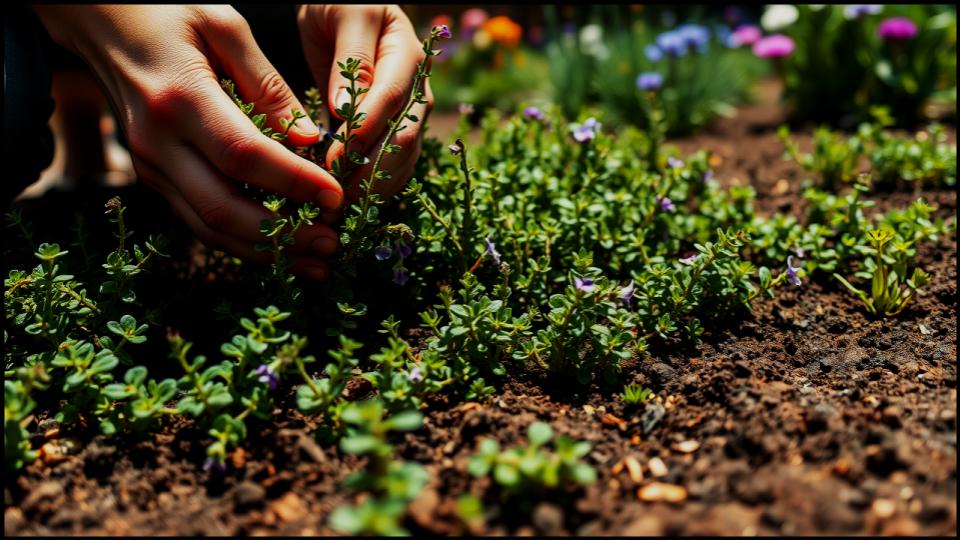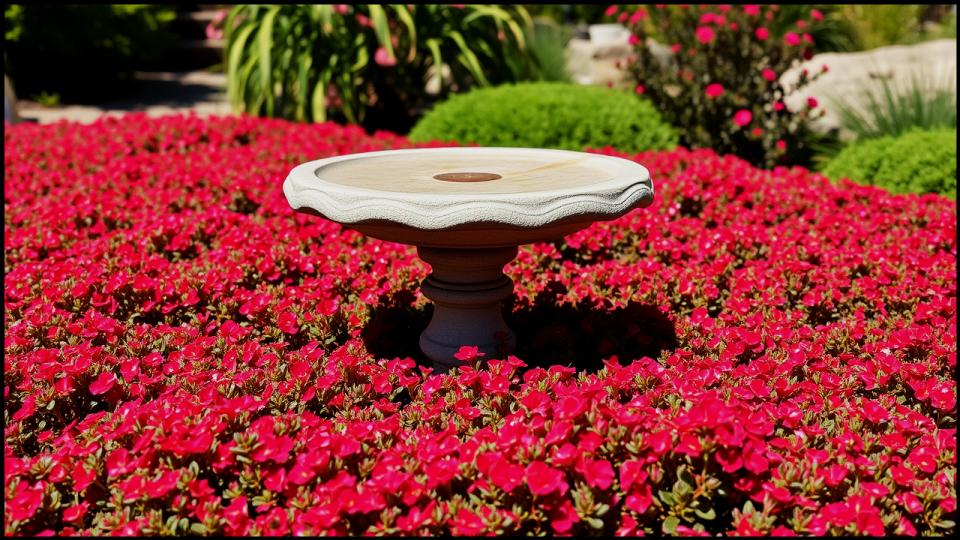
Imagine stepping onto a garden path and being greeted not by hard stone, but by a soft, fragrant cushion of green that releases a gentle, herbal scent. This isn’t a scene from a fairytale; it’s the everyday magic you can create when you grow creeping thyme. This hardy, beautiful, and wonderfully low-maintenance plant is a true garden problem-solver, weaving a living tapestry of color and fragrance wherever it goes. Whether you dream of a flowering lawn, charming pathways, or rock gardens that buzz with happy bees, this guide will show you how to make it a reality, the easy way.
Quick Tips for Thyme Success
Here’s what you need to know to get started with this resilient herb:
- Full Sun is a Must: Creeping thyme thrives in at least six hours of direct sunlight daily for the densest growth and best blooms.
- Drainage, Drainage, Drainage: This plant’s number one enemy is wet feet. It loves gritty, sandy, or rocky soil that drains quickly.
- Space to Spread: When planting, space individual plants about 8 to 12 inches apart. They’ll fill in the gaps surprisingly fast.
- Water Wisely: Water new plants regularly to get them established, but once they’re settled, they are remarkably drought-tolerant.
Why Choose Creeping Thyme? A Garden Problem-Solver
Long before it became a darling of landscape designers, creeping thyme (Thymus serpyllum and its relatives) was a tough little plant clinging to rocky hillsides in Europe and North Africa. That rugged heritage is exactly what makes it such a star in the modern garden. It’s not just a pretty face; it’s a practical, hardworking herb that solves a multitude of common garden challenges.
First and foremost, it’s an exceptional creeping thyme ground cover. Its dense, mat-forming habit is brilliant for suppressing weeds. Once it knits together, very few unwanted plants can push through its thick foliage. In my own garden, I’ve used it to choke out persistent weeds on a dry, sunny slope where nothing else seemed to work.
Beyond its utility, creeping thyme is a gift to our pollinators. When it erupts in a blanket of pink, purple, or white flowers from late spring into summer, it becomes a crucial food source for bees and butterflies. According to the University of Minnesota Extension, its blooms are a fantastic addition to any pollinator-friendly landscape. It’s a simple way to create a garden that is not only beautiful for you but also beneficial for the environment. Add to that its resistance to deer and rabbits, and you have a nearly perfect plant.

The Best Creeping Thyme Varieties for Your Garden
While you can’t go wrong with classic wild thyme, exploring different varieties opens up a world of texture and color. Choosing the right one depends on your aesthetic and how you plan to use it.
- Thymus serpyllum ‘Elfin’: This is my go-to variety for planting between stepping stones. ‘Elfin’ is incredibly tight, dense, and slow-growing, forming a perfect, miniature green carpet that can handle moderate foot traffic. It blooms with lovely lavender-pink flowers.
- Thymus coccineus ‘Red’: Often sold as Red Creeping Thyme, this variety delivers a spectacular show. It creates a stunning sea of vibrant magenta-pink flowers that is simply breathtaking. It’s a vigorous spreader and fantastic for covering large areas or cascading over walls.
- Thymus pseudolanuginosus (Woolly Thyme): For a purely textural experience, Woolly Thyme is unmatched. It has soft, fuzzy, silver-gray leaves and rarely flowers, making it all about the foliage. Because its leaves are so downy, it prefers less foot traffic and absolutely impeccable drainage, according to sources like Gardenia.net. It’s perfect for the edges of paths and in rock gardens where you can appreciate its unique softness.
- Thymus ‘Pink Chintz’: An early bloomer, ‘Pink Chintz’ offers a carpet of fuzzy, gray-green leaves and produces masses of salmon-pink flowers. It’s a vigorous grower and has excellent heat tolerance.
Planting Creeping Thyme: A Step-by-Step Guide
Whether you start with plants or seeds, getting creeping thyme established is straightforward. The key, as with all Mediterranean herbs, is to mimic its native habitat: sunny, lean, and well-drained.
Starting from Plants (The Easy Way)
Purchasing nursery starts is the fastest way to a lush thyme carpet. Spring or early fall are the ideal times for planting creeping thyme.

TOOLS AND MATERIALS BOX:
- Nursery Plants: Choose healthy-looking plants without yellowing leaves.
- Trowel: For digging individual planting holes.
- Garden Fork: To loosen compacted soil.
- Coarse Sand or Pea Gravel: To amend heavy or clay soil and improve drainage.
- Watering Can or Hose: For initial watering.]
End list
- Prepare the Site: Choose your sunniest spot. Use a garden fork to loosen the soil to a depth of about 6 inches. If your soil is heavy or clay-like, this is the most critical step. Amend it by working in a generous amount of coarse sand or fine gravel to improve drainage, as recommended by horticultural experts at North Carolina State University Extension.
- Determine Spacing: Arrange your plants on the soil surface before you dig, spacing them about 8 to 12 inches apart. For a faster fill, you can go as close as 6 inches.
- Plant: Dig a hole for each plant that is just as deep as its root ball and slightly wider. Gently tease out the roots if they are circling in the pot, place the plant in the hole, and backfill with soil. The crown of the plant (where the stems meet the roots) should be level with the surrounding soil.
- Water In: Water the area thoroughly after planting to settle the soil and eliminate air pockets. Keep the soil moderately moist for the first few weeks until you see signs of new growth.
Growing from Seed (For the Patient Gardener)
Growing from seed is more economical for large areas but requires more time. Reputable seed suppliers like Sow Right Seeds suggest starting indoors for the best results.
- Start Indoors: Sow seeds in a tray filled with seed-starting mix 6-8 weeks before your last frost date.
- Surface Sow: The tiny seeds need light to germinate, so press them lightly onto the surface of the mix—do not cover them with soil.
- Wait for Germination: Keep the mix moist and warm (around 70°F or 21°C). Germination can be slow, sometimes taking up to three weeks.
- Transplant: Once the seedlings have several sets of true leaves and the danger of frost has passed, harden them off and plant them outdoors as described above.
The Art of Creeping Thyme Care
One of the greatest joys of this plant is its self-sufficiency. Proper creeping thyme care is more about what not to do.
A common mistake I see is gardeners killing thyme with kindness, usually in the form of overwatering. Once established, creeping thyme is very drought tolerant. Water deeply but infrequently, only when the soil is dry to the touch. It’s far more likely to suffer from root rot in soggy soil than from thirst.
Fertilizer is generally unnecessary. Creeping thyme thrives in lean soil, and adding too much fertilizer can lead to weak, leggy growth with fewer flowers. If your soil is exceptionally poor, a light topdressing with compost in the spring is plenty.
As the plants age, they can become a bit woody in the center. To keep them vigorous and dense, give them a light “haircut” with shears after they finish blooming. This encourages fresh, new growth and maintains a tidy appearance. For larger thyme lawns, you can even use a lawn mower on its highest setting.
Designing with a Fragrant Carpet: Styling Ideas
Creeping thyme is as versatile in design as it is hardy. Its low, spreading habit makes it a natural choice for softening hardscapes and adding a touch of rustic elegance.
- Between Pavers: This is the classic use for a reason. Planting thyme in the gaps of a flagstone patio or walkway transforms a simple path into a sensory experience. Every step releases its wonderful fragrance. ‘Elfin’ or other very low-growing varieties are ideal here.
- A Thyme Lawn: For a low-water, low-maintenance, and pollinator-friendly lawn alternative in a sunny area, creeping thyme is a superb choice. As publications like Garden Design magazine highlight, it creates a durable, fragrant surface that needs no mowing (unless you want to tidy up spent flowers).
- Rock Gardens & Walls: Let thyme do what it does in the wild: spill over rocks and cascade down walls. Its drought tolerance makes it a perfect companion for succulents and other rock garden plants, filling in crevices and adding a soft, colorful layer.

Troubleshooting Common Issues
Thankfully, this list is very short. Creeping thyme is remarkably pest and disease-resistant.
The primary issue, as mentioned, is root rot. If you see your thyme developing brown or mushy patches, poor drainage is almost always the culprit. The only cure is to improve the drainage by amending the soil with sand or gravel.
In very hot, dry conditions, spider mites can occasionally be a problem. According to the NC State Extension Gardener Plant Toolbox, you might notice fine webbing on the leaves. Often, a strong spray of water from the hose is enough to dislodge them.
A Tapestry of Your Own Making
Growing creeping thyme is one of the most rewarding and low-effort projects a gardener can undertake. It asks for so little—just a patch of sun and soil that doesn’t hold water—and in return, it gives back so much. It offers fragrance, color, texture, and a living carpet that supports the ecosystem of your garden. Now you have all the secrets to success. Go ahead and plant a patch; your garden paths, your pollinators, and your senses will thank you for it.
